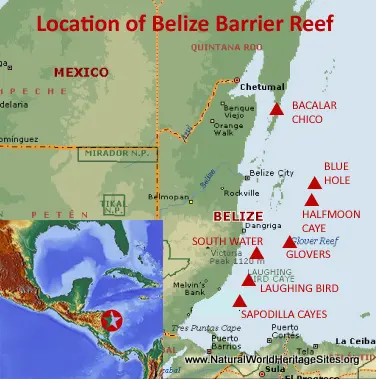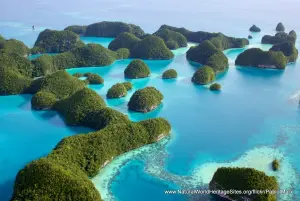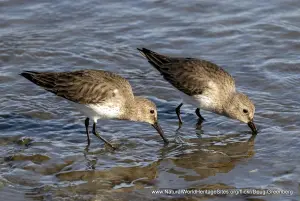EXPLORE Belize Barrier Reef Reserve System with this slideshow, check the location map and get all the facts and information below.
For slideshow description see right or scroll down (mobile). Click to view slideshow
Location and Values: The Belize Barrier Reef Reserve System includes seven of the most intact parts of the barrier reef that flanks the Central American coastline in the western Caribbean. The reef complex is the largest fringing barrier reef in the northern and western hemispheres, and the Belize Reserve System covers 12% of its total area with all its key elements including inshore, mid-shelf and shelf-edge coral reefs, offshore atolls, coastal lagoons, large seagrass meadows, mangrove forests and hundreds of sand cays. The seven reserves include the world-famous Blue Hole, as well as Bacalar Chico, Glovers Reef and the Laughing Bird, Half Moon, South Water and Sapodilla Caye Marine Reserves and Natural Monuments. The reef habitats support an enormous diversity of marine species, including threatened green, hawksbill and loggerhead turtles, West Indian manatees and American marine crocodiles. Major seabird colonies are protected, including those of red-footed and brown boobies as well as common noddy and frigate birds.
Conservation Status and Prospects. According to IUCN’s Conservation Outlook Assessment (2020) the conservation status of the Belize Barrier Reef Reserve System remains of ‘significant concern’, despite recent progress in addressing a number of significant threats to the site. The site was inscribed on the List of World Heritage In Danger in 2009, primarily because of the destruction of mangroves for coastal tourism development. Since then there has been considerable improvement in the planning and regulatory framework, with development of an Integrated Coastal Zone Management Plan as well as new legislation to protect mangroves and manage fisheries in a more ecologically-sustainable way. In addition a moratorium on oil exploration within the entire maritime zone of Belize has been agreed. However, there are still significant concerns over the implementation of these new arrangements, and the threats from coastal zone development, tourism growth, invasive species and climate change remain real, until it can be demonstrated that the new measures are having the necessary impact.
Links:
Google Earth
Official UNESCO Site Details
IUCN Conservation Outlook
UNEP-WCMC Site Description
Birdlife IBA
Slideshow description
The slideshow ‘tells the story’ of the Belize Barrier Reef Reserve System with a portfolio of photos that illustrate some of the main features of the reserves, and the marine life that inhabits the reefs. The slideshow starts with some impressive aerial views of the Blue Hole, before plunging underwater to explore the enormous diversity of marine life, including the area’s corals, fish, turtles and crustaceans. Some seabird colonies are shown together with mangrove forests where marine crocodiles may lurk unnoticed, while nearby seagrass beds are inhabited by West Indian manatees. The slideshow continues with further photos of the complexity of marine life, including sharks and the endemic Caribbean reef squid, with additional views pristine coconut-shaded beaches on some of the sand cayes.
The following Flickr photographers and other sources are acknowledged with thanks for their contributions to this slideshow: Gordon McIntyre, tobze, Eric Heupel, Alfonso Gonzales, cyberartist, Ruth, Adam, Annika Lindkvist, Bernard Dupont, Bernt Rostad, Brenda Dobbs, Cecilia Schubert, Chris Goldberg, David Petit, Doug Finney, dronepicr, flickkerphotos, It’s a blue world, Kent Wang, Kristin Enns Kavanagh, Mark Yokoyama, melenama, Sarah Elliott, Shaunn McAuliffe, tarykaylor, USAID Biodiversity and Forestry and Viv Lynch.
Factfile
Website Category:
Marine & Coastal
Area: 963 km2
Inscribed: 1996
UNESCO Criteria:
- Exceptional natural phenomenon (vii);
- Outstanding natural beauty (vii);
- Ecological processes (ix);
- Natural habitat for biodiversity (x);
- Significant number of rare, endemic and/or endangered species (x)





